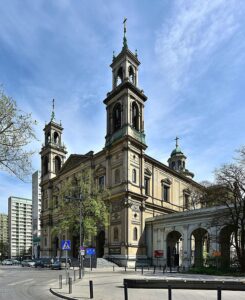The Polish “Parish Priest of the Ghetto” saved thousands of Jews from the Holocaust


The youngest prisoners of the ghetto, wikimedia (public domain); Fr. Marceli Godlewski. Credit: Franciscan Sisters of the Family of Mary, Warsaw
Before the war, he was considered a priest who had no sympathy for the Jews but during the holocaust, he became a precious help for the inhabitants of the Warsaw ghetto: the parish of Fr Marcel Godlewski became a home for many. On the International Holocaust Remembrance Day, we are presenting the profile of this Polish priest – Righteous Among the Nations.
“Father Godlewski. When I pronounce this name, I am overwhelmed with emotion. Passion and love in one soul” – said Professor Ludwik Hirszfeld, an outstanding doctor of Jewish origin, author of the blood group designations and discoverer of the cause of the serological conflict, saved by Fr. Marcel himself.
In 1938, approximately 370,000 Jews lived in Warsaw, that is, nearly 30 percent of the city’s population. The capital of Poland therefore had the biggest concentration of Jews in Europe and the second largest in the world, just behind New York.
In 1915, Father Marcel Godlewski became the parish priest of All Saints church, located in the very heart of the city. He especially devoted himself to the pastoral care of workers. Before the war, around 2,000 Jewish-Christians belonged to his parish.

Church of All Saints, view from ul. Hard, By Adrian Grycuk – Praca własna, CC BY-SA 3.0 pl, https://commons.wikimedia.org/w/index.php?curid=79903019
The profile of the parish on Grzybowski Square was changed when the Germans attacked Poland on 1 September 1939. Over 400,000 Jews were crammed into a district covering 2.4 percent of Warsaw. In November 1940, the Germans separated the ghetto from the “Aryan side” and the All-Saints parish found itself on the other side of the wall with 2,000 Jewish Catholics. There, hunger, disease, and human corpses in the streets were part of everyday life.
Father Godlewski obtained the Bishop’s consent to minister in the ghetto. Together with Father Czarnecki, they housed nearly 100 Jews in the presbytery. Despite the pervasive poverty in the ghetto, about the same number of people received food from the parish’s communal kitchen which served meals to the needy. Everyone could benefit from this help, regardless of whether they were baptized or not. In the parish priest’s family home, located outside the ghetto in the Anin district, the Franciscan sisters of the Family of Mary ran an orphanage, where half of the children were Jewish.
These aid activities could not have been carried out on such a large scale without false baptism certificates. That document was needed by the residents of the presbytery, children who were smuggled in or who wanted to escape from the ghetto.
“The baptism certificate then functioned like an ID card. It was a confirmation of identity. Hence its importance and the help that priests could provide by making false certificates. Printing these documents was legal because that was a normal, official activity of the Church,” explains Karol Madaj, co-author of the book “Ghetto parish priest” and acting director of the Pilecki Family House Museum in Ostrow Mazowiecka. As he adds, it can be estimated that in this parish about 700 certificates of this kind were issued during the war.
To make the certificate, it was necessary to search through the Death Register for a death certificate, most often of a child or infant, whose year of birth coincided with that of the person wanting to “break out” of the ghetto. The potential fugitive received the name and surname, date of birth and baptism of his “double” noted in the Register of Baptisms. He then received a false certificate of baptism and, with this document, moved out to the “Aryan” district. “I have personally known many of them and, to this day, they still use the assumed surname, recalled Fr. Czarnecki.
The entire relief operation carried out in the All-Saints church meant risking one’s life. On 15 October 1941, the German governor, Hans Frank, issued an ordinance forbidding Jews to leave their designated districts, under the threat of the death penalty. People providing shelter to Jews were to be subject to the same punishment, and any attempted acts were to be punished as if they had been committed. The decrees of the German local occupation authorities were even stricter, for people were put to death not only for providing shelter but also for helping in other ways.
In July 1942, the activity of Fathers Godlewski and Czarnecki ended with the great liquidation of the ghetto, during which the Germans sent over 300,000 Jews to the Treblinka gas chambers. It is not known exactly how many people Fr. Godlewski rescued, but the estimations go from a thousand to as many as three thousand Jews. All the children hiding in the orphanage in Anin survived the war.

In the years 1940–42, approximately 92,000 people died in the ghetto, mainly of hunger, cold and disease, By Bundesarchiv, Bild 101I-134-0783-06 / Knobloch, Ludwig / CC-BY-SA 3.0, CC BY-SA 3.0 de, https://commons.wikimedia.org/w/index.php?curid=5476160
Fr. Marcel Godlewski died in his home near Warsaw 75 years ago, on 25 December 1945. In 2009, he was awarded the Righteous Among the Nations medal for his services.
In 2017, the All-Saints church on Grzybowski Square in Warsaw was awarded the title “House of Life” – a title given by the Wallenberg Foundation to commemorate the places associated with saving Jews during the Holocaust. This is the first place in Poland that has received this distinction. “This was a place of life, a fortress of life; life had its headquarters here within the walls of this church, and the darkness could not overcome it,” said the son of the Foundation’s founder, Samuel Tenembaum.
Read also:
Poland: 76th anniversary of the Liberation of Auschwitz. Over 200,000 children killed >>>




Dodaj komentarz